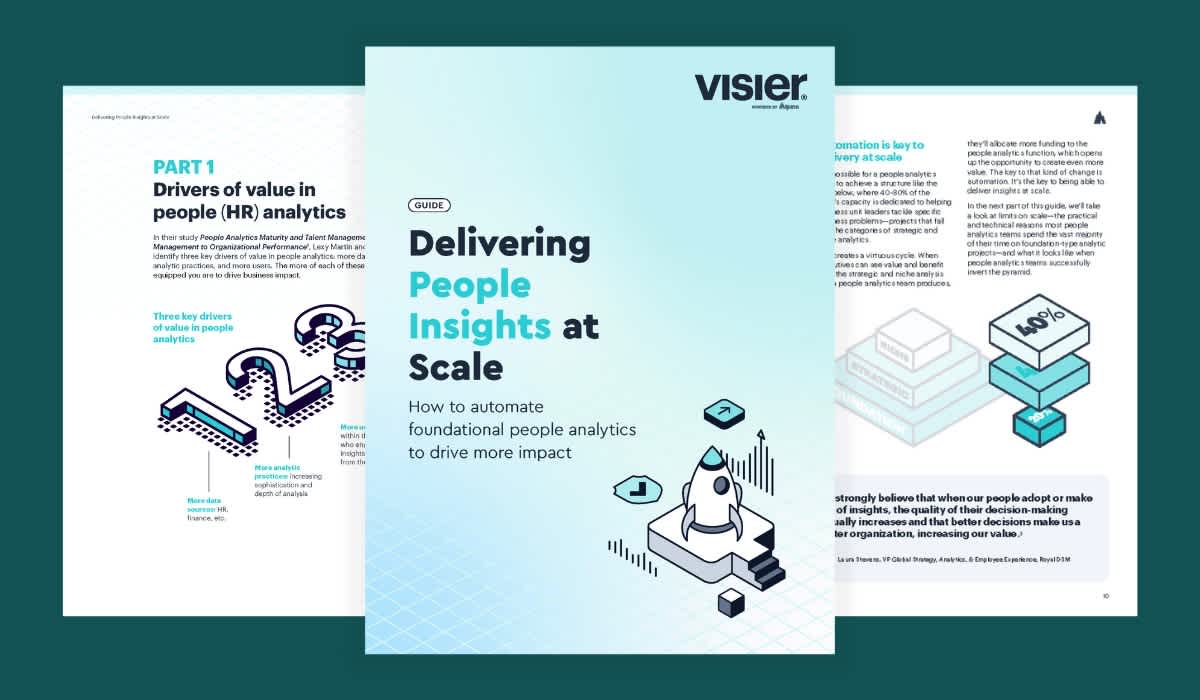Data Ingestion 101: Definition and Use Cases for HR Teams
Data ingestion is a critical step in being able to analyze and action key insights from data. Learn the basics of data ingestion here.

Data is one of your company’s most important assets. And the volume and value of data is growing exponentially each day. When this data is scattered across multiple databases and sources, using it becomes extremely challenging. Data ingestion is a critical step in data management, bringing the data to your fingertips.
What is data ingestion?
Data ingestion means gathering data from multiple sources into a single warehouse, database, or other repository. The goal is to have all the information in one place so that you can later review and analyze it.
The data collected at this stage is raw and will often come in multiple formats. During ingestion, you don’t have to worry about verifying data or transforming it. These are steps that will come at a later time. Data ingestion is the first step in the data management process and helps you ensure data is available and complete.

Data integration vs. data ingestion
Data ingestion is where you collect data from various sources. But at this stage, your information will probably be unusable. Multiple formats, duplicate or missing information, and other issues will make data analysis challenging, if not impossible.
Data connectors are often critical in this process, bringing together multiple sources easily and integrating with your existing systems.
Data integration transforms data, bringing it to a unified format that is easier to access and analyze by both humans and machines. It is the next step in the data management process after ingestion and is critical for any business that wants to use data in its decision-making process.
How do they work together? Imagine your HR department is trying to analyze employee performance. They have to gather information from various sources, such as performance reviews, training logs, attendance records, and other metrics. The first step will be data ingestion—bringing all the data from all sources into a single destination.
Looking at the data now, you may notice multiple mistakes. Dates could be in different formats, while some information may be missing from one source, but not from another.
This is where data integration comes in, helping to transform and clean the data, resolve inconsistencies, and create a cohesive dataset. Once that’s done, HR can use the data to analyze it and create reports.
Key benefits of data ingestion
Making data-driven decisions is the best way to ensure you’ll reach your business goals. But for that, you need to use correct and complete information. Data ingestion is the first step in that process.
Here are some of the main benefits of data ingestion:
Data availability. Data ingestion collects data from various sources, bringing it to a single source and ensuring the data you need is always available at your fingertips.
Data quality. While you won’t be transforming data during ingestion, the process is critical in improving data quality. It helps clean and standardize data and remove errors and inconsistencies.
Scalability. As you gather more data in more silos, you can quickly start losing track of what’s what and where. Data ingestion tools can handle large volumes of data, accommodating data growth without compromising performance.
Time-saving. Searching for data manually through multiple sources is extremely time-consuming. Data ingestion automates the collection process, helping you save time and resources.
Types of data ingestion
There are multiple approaches to data ingestion. Your business, your goals, and your strategy will determine the best course of action. There are three main types of data ingestion:
Batch processing
Real-time processing
Lambda
Let’s explore each option.
1. Batch processing
Batching collects historical data from various sources and transfers it to the target application system. It is easier and cheaper to use than real-time alternatives and a good choice if you have large historical data sets.
You can trigger batching manually or automatically, depending on your preferences and the tools and systems you use.
And if you’re worried about data integration, the most common transformation pipeline—ETL (Extract, Transform, Load)—supports batching and helps convert data before it is loaded into the destination.
2. Real-time processing
Also known as stream processing, real-time processing transfers your data continuously from source to target. Its main advantage is that you no longer have to wait for IT to transfer batches of data. Instead, you have everything ready in real-time.
Real-time processing can be faster than other types of ingestion, and you can also use it alongside real-time analytics techniques. Some say security is a bigger issue with real-time ingestion as opposed to batching. However, modern data ingestion tools and cloud-based systems make the process a lot safer, putting security and privacy first.
3. Lambda architecture
The lambda architecture is a combination of the above two types of data ingestion. It consists of three layers. The first two layers transfer data in batches. The third layer works with data in real time, transferring anything the first two layers couldn’t. The architecture ensures there is always a balance between the three layers with minimal latency.
Sample data ingestion process
Like the type of data ingestion you choose, the process will vary depending on your business, systems, and goals. But there are a few steps you’ll likely need to take regardless of these variables.
1. Source identification
Before you can begin collecting data, you’ll need to identify all your sources. If you don’t, you’re at risk of working with incomplete or incorrect data. Sources may include databases, log files, APIs, spreadsheets, external systems, and other repositories.
2. Data collection
Now that you know your sources, it is time to collect the data. In this step, you’re not focused on transforming or even checking the data for errors. You’re simply gathering it all from its source.
3. Security consideration
Before you can work with the data, you need to prioritize security and privacy. Your data will often be the most vulnerable during the transportation process, but you’ll also need to ensure security at the destination. Methods like access control and encryption are the most common and useful, but adapt as you see fit.
4. Data transportation
The next step in your ingestion process will be data transportation. Here, you can use various methods, such as batching, streaming, and more.
Once you store data in its final destination, the ingestion process is complete. Optionally, you can continue with data integration, cleaning, and transforming data to bring it to a format you can use for analysis and reporting.
How HR teams can use data ingestion
HR teams need to use data constantly. From talent acquisition to employee management and understanding things like turnover and engagement, data is the core of it all. Data ingestion can make all these processes easier. Here are a few examples.
Recruitment analytics
Improving your talent acquisition process starts by analyzing your current recruitment strategy. Data ingestion can help you collect data from recruitment platforms, applicant tracking systems, and more.
Having the information in one place will make it easier for the HR team to access it when they need it. From there, you can analyze data to see bottlenecks in your recruitment process and optimize it.
Workforce planning
This strategy can help you identify future workforce needs and skill gaps and develop strategies for recruitment or succession planning.
Data ingestion assists you by allowing you to collect data from sources related to demographics, performance, training, and skills. Once you have all the data you need, you can transform it and use things like people analytics to understand your current and future workforce needs.
Employee engagement
Engagement is critical for your workforce. Engaged employees perform better and stay with the company longer. But engagement is also one of the most difficult HR metrics to track. There’s no formula to tell you exactly what’s happening.
Your best option is to look at data from multiple sources to understand how engaged your employees are. Sources can include employee surveys, feedback tools, collaboration platforms, and more. Once data is ingested and transformed, you can use it to understand workplace satisfaction and identify areas for improvement.

Data ingestion tools and core capabilities
There are several data ingestion tools to choose from. The best ones? Those that align with your business goals and your system. When selecting the right tool, there are some core capabilities you want your platform to have.
These include:
Data extraction. Any ingestion tool should be able to extract data from the source to transport it to its final destination.
Scalability. Your data is likely to grow in time, so select a tool that allows you to do that without compromising efficiency.
Security and privacy. Data privacy and security are not risks you should take lightly, so make sure your data ingestion tool has sufficient measures in place.
Data processing. Whether it’s batching, streaming, or a combination of the two, you want a data ingestion tool that’s ready to process the data.
Data flow tracking. Last but not least, make sure your ingestion tool allows you to visualize and keep track of the flow of data. This will help minimize errors, making sure the entire process is seamless.
Data connectors play an important role in ingestion, enabling the extraction, transformation, and transfer of data from one source to another.
Regardless of the tools you use, data ingestion is an essential step if you want to make data-driven decisions. It brings all your information in one place, making it easy to access and keep track of.
Learn more about how to ingest people data and business data into Visier here.
On the Outsmart blog, we write about people analytics and HR technology topics like how bad data can’t stop good people analytics, the benefits of augmented analytics, and everything you need to know about HR data sources and HR data connectors. We also report on trending topics like artificial intelligence, using generative AI in HR, and how skills are rapidly evolving, and advise on people data best practices like how to ingest people data and business data, how to turn source data into insights, and reports vs. analytics. But if you really want to know the bread and butter of Visier, read our post about the benefits of people analytics.



